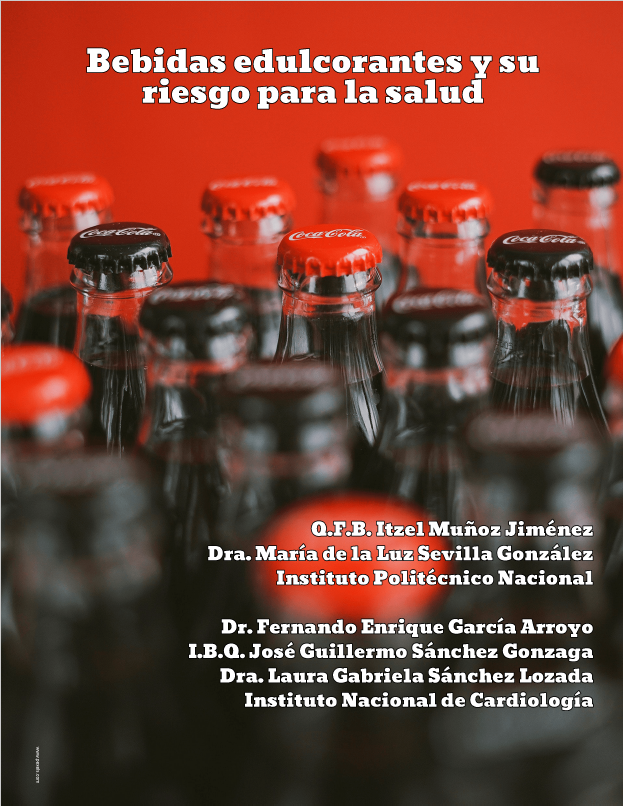Bebidas edulcorantes y su riesgo para la salud
Resumen
Aunque las sensaciones primarias del gusto son los sabores: dulce, salado, acido y amargo, La gran mayoría de las personas eligen los alimentos y bebidas con un gran sabor dulce, desde el punto de vista de salud, una opción para sustituir a estas bebidas son los edulcorantes no calóricos los cuales pueden ayudar para el control de algunas enfermedades crónicas ya que la población mexicana presenta un alto consumo de bebidas endulzadas calóricas como los refrescos, jugos y té con azúcar agregada y los edulcorantes no calóricos pueden sustituir fácilmente el dulce sabor del azúcar. Sin embargo, cuando se consumen bebidas no calóricas se recomienda tener una dieta correcta junto con actividad física, debido a que no existe evidencia científica que exista un edulcorante "perfecto". Actualmente hay información acerca de los posibles riesgos y beneficios del uso de los edulcorantes que sustituyen al azúcar, sin embargo, es necesario más investigaciones científicas que aporten datos concluyentes sobre su efectividad y seguridad a largo plazo.
Descargas
Citas
[2] S. E. Swithers, A. A. Martin, y T. L. Davidson, High-intensity sweeteners and energy balance", Physiol. Behav., vol. 100, num. 1, pp. 55{62, abr. 2010.
[3] G. M. Singh et al., Estimated Global, Regional, and National Disease Burdens
Related to Sugar-Sweetened Beverage Consumption in 2010.", Circulation, vol. 132, num. 8, pp. 639-66, ago. 2015.
[4] S. J et al., Artificial Sweeteners Induce Glucose Intolerance by Altering the Gut Microbiota", Nature, vol. 514, n_um. 7521, 2014.
[5] J. M. Taylor, M. A. Weinberger, y L.Friedman, Chronic toxicity and carcinogenicity
to the urinary bladder of sodium saccharin in the in utero-exposed rat", Toxicol. Appl. Pharmacol., vol. 54, n_um. 1, pp. 57-75, jun. 1980.
[6] Y. Yu et al., \Risk factors for bladder cancer: A case-control study in Northeast
China", Eur. J. Cancer Prev., vol. 6, num. 4, pp. 363-369, 1997.
[7] G. D. Wu et al., \Linking long-term dietary patterns with gut microbial enterotypes",
Science (80-. )., vol. 334, num. 6052, pp. 105-108, oct. 2011.
[8] M. S. A. Palmnäs et al., Low-dose aspartame consumption diferentially affects gut microbiota-host metabolic interactions in the diet-induced obese rat", PLoS One, vol. 9, n_um. 10, oct. 2014.
[9] J. L. Kuk y R. E. Brown, Aspartame intake is associated with greater glucose intolerance in individuals with obesity", Appl. Physiol. Nutr. Metab., vol. 41, num. 7, pp. 795-798, mar. 2016.
[10] S. S. Gul et al., Inhibition of the gut enzyme intestinal alkaline phosphatase may explain how aspartame promotes glucose intolerance and obesity in mice", Appl. Physiol. Nutr. Metab., vol. 42, n_um. 1, pp. 77-83, 2017.
[11] G. S. Portela, R. Azoubel, y F. Batigalia, Effects of aspartame on maternalfetal and placental weights, length of umbilical cord and fetal liver: A kariometric experimental study", Int. J. Morphol., vol. 25, num. 3, pp. 549-554, 2007.
[12] C. E. Bryant, L. K. Wasse, N. Astbury, G. Nandra, y J. T. McLaughlin, Nonnutritive sweeteners: No class effect on the glycaemic or appetite responses to ingested glucose", Eur. J. Clin. Nutr., vol. 68, num. 5, pp. 629-631, 2014.
[13] Y. Liang, G. Steinbach, V. Maier, y E. F. Pfei_er, The effect of artiffcial sweetener on insulin secretion: 1. The effect of Acesulfame K on insulin secretion in the rat (studies in vivo)", Horm. Metab. Res., vol. 19, num. 6, pp. 233-238, 1987.






